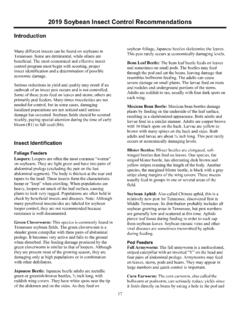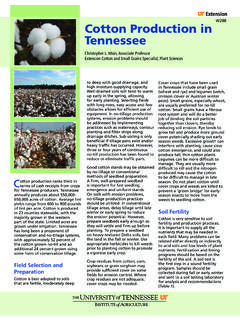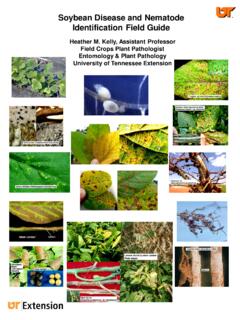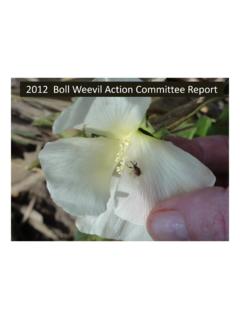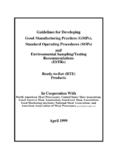Transcription of 2018 Corn Insect Control Recommendations - UT Crops
1 2019 corn Insect Control Recommendations Insects rob Tennessee corn producers of about five Seed and At-Planting Insecticide Treatments: Almost percent of their potential yields on an annual basis. all seed corn comes treated with insecticide. These However, severe pest infestations can cause complete insecticides will Control or suppress a number of seed crop loss. While pesticides play an important role in crop and seedling Insect pests. Insecticide seed treatments, protection, they should be used only when there is the specifically Poncho and Cruiser, have largely replaced potential for damage severe enough to cause economic the use of in-furrow or banded insecticides which were loss. There are several cultural practices that can be used often applied at planting. However, at-planting to reduce Insect problems and minimize pesticide use.
2 Insecticides can still be used for supplemental Control of Scouting fields for Insect infestations and monitoring seed and seedling pests, or higher than standard pest populations with pheromone traps can provide an insecticide seed treatment rates can sometimes be estimate of Insect pressure in a field, and thus, help to requested (see tables below). guide any treatment decisions. Consider using higher labeled insecticide seed treatment Prevention rates or supplemental at-planting insecticides when: You have a known soil Insect problem. Early Planting: Planting field corn early, during the Planting in a field that was fallow, pasture, sod, recommended planting window, will reduce the chances or a cover crop was planted and not terminated of crop damage from several Insect species. For at least 3-4 weeks before planting. example, corn borers and fall armyworm are frequent pests of late-planted corn in Tennessee.
3 Weed Control : Certain insects carry (or transmit) virus diseases in corn . By controlling weeds such as Johnsongrass early in the season, the chances of leafhoppers and aphids transmitting viruses to corn are reduced. When planting corn in fields known to be heavily infested with Johnsongrass, choose a hybrid with good tolerance to the Maize Dwarf Mosaic Virus (MDMV) complex. Tillage: No-tillage production can increase soil Insect pest problems in many cases. Cutworms, wireworms, white grubs, seedcorn maggots and lesser cornstalk borers may build up in grass sod or where previous crop residue has been left on the soil surface at planting. Burndown with herbicides well in advance of planting (3-4 weeks) can reduce the risks of infestation. Look for white grubs, wireworms and any other insects that may be exposed during land preparation.
4 27. Relative Efficacy of Selected Insecticide Seed Treatments on Seed and Seedling Insect Pests Active Ingredients White Wire- Seedcorn Sugarcane Stink Chinch Southern corn Western corn Trade Names* Billbugs Cutworms and Rates* grubs worms maggot beetle** bugs bugs rootworm rootworm Poncho 250, Acceleron, clothianidin, mg NL F G E P-F F F G E P, NL. NipsIt Inside ai/kernel Poncho 500, Acceleron clothianidin, mg F. with Poncho Votivo, NipsIt E G E P-F G F-G G-E E P. ai/kernel Inside Poncho 1250, Acceleron with Poncho Votivo 1250, clothianidin, mg G E E E F-G G G E E G. PPST + Poncho ai/kernel 1250/Votivo, NipsIt Inside Cruiser Maxx 250, thiamethoxam, NL F G E P P P F G - E, NL P, NL. PPST 250 mg ai/kernel Cruiser Maxx corn 500, thiamethoxam, NL G G E P F? F F E P, NL. Avicta Complete corn 500 mg ai/kernel Cruiser Maxx corn 1250, thiamethoxam, G E E E F F?
5 G G E P. Avicta Complete corn 1250 mg ai/kernel 28. thiamethoxam, mg ai/kernel; E. PPST 250 plus Lumivia G? VG? E G? P P F G - E, NL NL. chlorantraniliprole, mg ai/kernel Gaucho 600, Dynashield, imidacloprid, Imidacloprid 5, Nitro Shield, mg ai/kernel P, NL G G E P, NL P, NL P, NL F G, NL P, NL. Senator 600, etc. (mid labeled rate). imidacloprid, P, NL P, NL P, NL. Latitude F, NL G G P, NL F, NL G, NL P, NL. oz/100 lb seed imidacloprid, P, NL P, NL P, NL G, NL. Concur F G G P, NL F, NL P, NL. oz/42 lb seed E = excellent, G = good, F = fair, P = poor or no activity, ? = insufficient data to provide confident ranking, NL = pest not listed on label. Some ratings are based on incomplete data and are only meant to provide a general guideline of relative efficacy to the best knowledge of the author. Parts of this table are courtesy of Auburn University s corn Insect , disease, nematode, and weed Control Recommendations for 2017.
6 * Formulated product may also include fungicidal and/or nematicidal ingredients that are not listed. ** Efficacy of seed treatments on sugarcane beetle is dependent upon the timing of infestation. Expect less Control if infestations occur several weeks after emergence. 28. Examples of At-Planting Treatments for Seed and Seedling Insect Pests Insecticide (Trade Names) Rates Common Pests Controlled or Suppressed chlorpyrifos (Lorsban 15G)* 8 - 12 oz/1000 row ft Seedcorn maggot, Southern corn rootworm, Wireworms, White grubs, Cutworms terbufos (Counter 20G)* 5 - 6 oz/1000 row ft Seedcorn maggot, Southern corn rootworm, Wireworms, White grubs cyfluthrin, tebupirimphos (Aztec )* oz/1000 row ft Seedcorn maggots, Southern corn rootworm, Wireworms, White grubs, Cutworms tefluthrin (Force 3G) 4 - 5 oz/1000 row ft Seedcorn maggots, Southern corn rootworm, Wireworms, White grubs, Cutworms bifenthrin (Brigade 2E, Discipline 2E, Fanfare 2E)** - oz/1000 row ft Seedcorn maggots, Southern corn rootworm, Wireworms, White grubs bifenthrin (Capture LFR )
7 - oz/1000 row ft Seedcorn maggots, Southern corn rootworm, Wireworms, White grubs, Cutworms, Sugarcane beetle -cyhalothrin (Ballista LFC 1) oz/1000 row ft Seedcorn maggots, Southern corn rootworm, Wireworms, White grubs, Cutworms See the insecticide label for specific use instructions. * Caution: When using organophosphate insecticides such as Aztec, Counter or Lorsban with herbicides such as Accent, Callisto, Capreno, Halex GT, Steadfast, Option or Resolve, the possibility for plant injury exists. See herbicide label for restrictions. ** Many other pyrethroid insecticides are labeled for at-planting Control of cutworms and some other pests. These include Asana XL, Baythroid XL, Declare, Mustang Max and Pounce. Please see their labels for specific use instructions. Scouting corn clusters of 50 to several hundred on corn leaves and other vegetation.
8 Seedling corn : Check twice weekly for cutworms, seedcorn maggots, armyworms, white grubs and other Silking/Tasseling Stages: Examine plants for pests of seedling corn . Walk in a zigzag pattern European and southwestern corn borers. Look for egg through the field, checking at least 10 places in the masses or small larvae feeding on the leaves. corn field. Count the number of damaged plants in 10 feet borers lay their egg masses on the middle third of the of row. Check at least 100 plants. Look for silken plant near the ear zone. Check on the undersides of tubes at the bases of plants for lesser corn stalk borers. leaves for these egg masses. Small larvae may be Plants less than 12 inches tall are most susceptible found between ear husks or behind leaf collars. It is to injury. important to correctly identify larvae which are found because corn borers, corn earworm and fall armyworm Whorl-Feeding Insects: corn fields should be may all be present.
9 Treatment for Insect pests during checked at least weekly until the crop is mature to this stage will be more difficult. Insecticidal Control determine the presence of Insect pests or their damage. for corn borers in tasseling corn is generally not as Walk in a U-shaped pattern over the field. Sample 10. efficient as for plants in the whorl stage. Small larvae plants in 10 locations on a weekly basis, but fewer are more easily controlled than larger worms. plants can often be checked depending upon pest density. To check for live larvae, cut open at least two Black Light and Pheromone Traps: Black light traps (or more) plants in each sample and record the number can be used to monitor movement of adult insects. of larvae. Pheromone (sex-attractant) traps are also used to monitor various Insect flights, such as southwestern Look on the undersides of leaves for fall armyworm or corn borers.
10 Light or pheromone traps can be used to corn borer egg masses. Southwestern and European complement an effective scouting program. Traps can corn borers lay their eggs in an overlapping pattern be used in each county or on individual farms to that appears like small fish scales. However, provide producers with advance warnings of Insect southwestern corn borer egg masses are usually infestations. smaller (2-8 eggs) than those of European corn borer (10 or more eggs). Fall armyworms lay their eggs in 29. Bt corn Traits: Bt corn for the Control of corn borers corn rootworm Control are seldom needed. However, is typically recommended on at least part of a grower's continuous corn production in the same field increases acreage and particularly in late planted fields. The the likelihood of western corn rootworm infestations. table below is intended to provide growers with the Resistance management guidelines for Bt corn information needed to help them select among the require a producer to plant a refuge of non-Bt various Bt trait packages offered by seed distributors.
